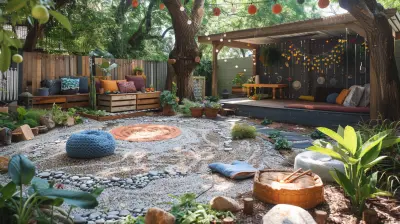How to Encourage Siblings to Find Common Interests
23 October 2025
Ever hear your kids yelling from the other room and wonder if world peace is easier to achieve than sibling harmony? You're not alone. As a parent, watching your children bicker over screen time, toys, or who's breathing too loudly can feel exhausting. But here's the thing—underneath all that rivalry, there's great potential for a strong sibling bond. One of the best ways to unlock that bond? Help them find shared interests.
This post is all about how to encourage siblings to find common ground—and actually enjoy each other's company. Yep, it's possible! Let's dive in with realistic, tried-and-true strategies that can make a real difference in your home.
Why Shared Interests Matter Between Siblings
Before we jump into the how, let’s talk about the why.Shared interests can be the glue that holds sibling relationships together. Think about your closest friends. There’s a pretty good chance you bonded over something—music, a hobby, or a favorite movie. Siblings are no different. When kids have something they both enjoy, they learn to collaborate, compromise, and appreciate each other’s company. That shared interest becomes their secret handshake, their inside joke—it’s connection in its purest form.
And let's not forget: siblings are often each other’s longest relationships. Helping them build that foundation now can pay off for years to come.
Understand That It Won’t Happen Overnight
First things first—don’t expect miracles. You can’t force your kids to love the same things in a day. Finding common ground takes time, patience, and a little creativity. Think of it like planting a seed—it needs sun, water, and time to grow.Every child is unique, even if they share the same last name and bathroom. One might love painting while the other can’t sit still long enough to pick up a brush. That’s okay! Your job isn't to make them the same—it’s to help them appreciate what they can enjoy together.
Step 1: Observe Their Interests Individually
Before you can find that sweet middle ground, you’ve got to really know what each child enjoys on their own.- What lights them up?
- What do they talk about non-stop?
- When are they the happiest?
Take mental notes. You might notice that one child loves building Legos, while the other is obsessed with drawing. Maybe there’s a way to combine that—like designing Lego cities and drawing them out.
Look for overlap, even if it seems subtle. Sometimes common interests aren’t sitting there obvious with a bow on top—you have to dig a little.
Step 2: Create Opportunities for Compromise
One of the most powerful lessons siblings can learn from each other is compromise. And you, dear parent, get to be their guide.Let’s say one child wants to play soccer and the other wants to bake cookies. Why not set aside time to do both together—first soccer, then baking? That “trade time” teaches them that relationships are give-and-take.
You can even set up a “Siblings Day” each week where they take turns picking the shared activity. The rule? Everyone has to participate willingly and with a good attitude—no eye rolls allowed.
Step 3: Encourage Team-Based Activities
Nothing brings siblings together like being on the same side.Look for activities where they can work toward a common goal:
- Building a puzzle
- Putting on a play
- Creating a comic book
- Playing co-op video games
- Setting up a lemonade stand
When they have to rely on each other to succeed, they start to see each other not as competition but as teammates. That’s gold.
And don’t forget the power of shared victories. Celebrate their teamwork with something simple—ice cream, a movie night, a high five and a “Hey, you two really worked well together today.”
Step 4: Designate “Tech-Free” Family Connection Times
Let’s face it—technology can sometimes keep kids in their own bubbles. While screen time has its place, unplugging creates space for connection.Try carving out set blocks of time during the week for screen-free activities. Think board games, camping in the backyard, cooking a meal together, or old-fashioned storytelling.
When everyone’s unplugged, they’re more present—and more likely to engage with each other.
Step 5: Model It Yourself
Kids are little mirrors. If they see you bonding with others over shared interests, whether it’s your partner, a friend, or even them, they learn how connection works.Talk openly about your hobbies. If your children see you light up while talking about gardening or running or that novel you’re slowly reading (no judgment), they’ll learn that shared interests matter.
Even better—include them in your hobbies now and then. That way, they see firsthand how to invite someone else into something you enjoy.
Step 6: Celebrate Their Efforts—Not Just Their Success
Let’s be honest—siblings might not always click. Some days will be beautiful, others will be a mess. That’s okay. Focus on the process more than the results.Did one child take the time to share their favorite book? That’s a win.
Did they try a new board game together, even if it ended in a fight over who cheated? Still a win.
Reinforce any effort they make to connect, and remind them (and yourself) that relationships take work—but they’re worth it.
Creative Activities That Bring Siblings Together
Need a few starter ideas to get the ball rolling? Here are some fun, low-pressure options that encourage connection and shared experiences:1. Create a DIY Obstacle Course
Toss some pillows, string, and chairs around the living room and let them build a course together. Great for teamwork and tons of laughs.2. Make a Joint Art Project
Big poster. Markers. Paint. Glue. Let them go wild. Encourage themes like “Our Dream Vacation” or “What Makes Us Laugh.”3. Start a Sibling Book Club
Pick a fun, age-appropriate book they can read together (or listen to on audiobook), then talk about it over snacks.4. Film a Home Movie
Have them write a short script, assign roles, and use your phone to record their masterpiece. Bonus: it becomes a memory you’ll treasure forever.5. Cook or Bake Together
Whether it’s pancakes or pizza from scratch, cooking together can turn into a delightful mess (with some delicious results).Help Them Respect Differences, Too
Now, here's an important side note: common interests are great, but they're not everything. Your kids won't like all the same things—and that’s a good thing! Part of bonding is respecting each other’s unique tastes.Teach them how to be curious, not critical. If your daughter loves horses and your son is into space, help them ask each other questions about those interests. Curiosity breeds connection.
Remind them that liking different things doesn’t mean they can’t still be close. It just means their relationship is going to be rich and varied.
What If One Sibling is Much Younger?
Big age gaps can feel like a challenge, but they’re not impossible to bridge. In fact, they can be an opportunity.Look for universally loved activities like:
- Music (dancing is always a hit)
- Arts and crafts
- Dress-up and pretend play
- Simple games like “Simon Says” or “I Spy”
The older sibling may need encouragement to participate at a younger level—but remind them that they’re playing an important role. You can even frame it like they’re “teaching” the younger one something cool.
Over time, these interactions build trust and warmth, which lays the groundwork for shared interests as they both grow.
Tune Into Their Emotions
Sometimes, the resistance to spending time together has less to do with interests and more to do with feelings. Frustration, jealousy, and competition can put up walls fast.Make sure your kids feel seen and heard. If one child always feels overshadowed by the other, they may resist bonding. Try one-on-one time. Let each child know what makes them unique and special.
A solid emotional foundation helps them enter relationships with each other from a place of confidence instead of insecurity.
When to Step Back
Here’s a gentle reminder: It’s okay if your kids don’t become best friends right away—or ever. Some siblings are close; others aren’t. Your job isn’t to script their relationship—it’s to support it.Give them chances to bond, but don’t force it. Be patient. Step in when needed, but let them figure things out together, too.
Often, the most meaningful sibling bonds form slowly, quietly, over time—through laughter, little inside jokes, and the comfort of just knowing someone has your back.
Final Thoughts
Helping siblings find common interests is like helping them discover treasure: it takes time, effort, and a little digging. But when they strike gold, their relationship becomes one of the most valuable assets they’ll ever have.So, be the gentle guide. Be their safe observer, their biggest cheerleader, and occasionally, the peace negotiator. Show them that connection is worth it. And when they finally click over that one game, movie, or silly dance… you’ll know the effort paid off.
Now, go ahead and set the stage for some shared laughter today. One shared interest at a time, you’re building a lifelong bond.
all images in this post were generated using AI tools
Category:
Sibling RivalryAuthor:

Karen Hurst
Discussion
rate this article
1 comments
Mitchell Wilson
Stop forcing interests! Let them explore independently. Genuine connections grow when siblings discover shared passions on their own terms.
October 23, 2025 at 2:41 PM

Karen Hurst
Thank you for your perspective! I agree that allowing siblings to explore independently can foster genuine connections. This approach can complement structured activities, helping them to discover shared interests naturally.


